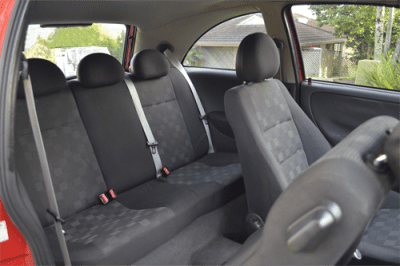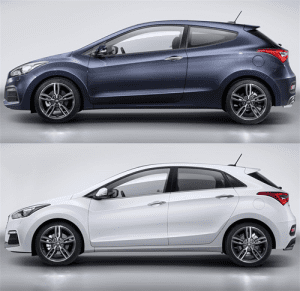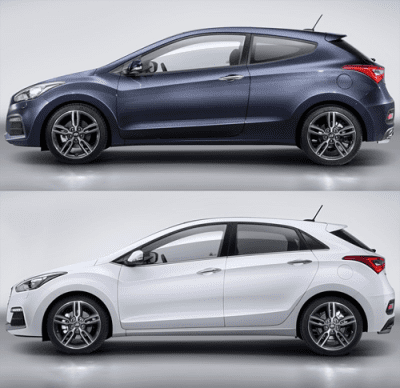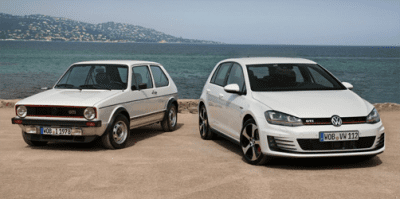
 Let me take you back to some childhood memories: if you’re born in Europe, it’s very likely that your parents had a compact 3-door hatchback to haul you (and potentially your siblings) around in the backseat. In order to reach that backseat, one of the front seats had to be folded forward, giving you just enough space between the seat-back and the B-pillar to dive in. This also meant it was virtually impossible for adults to get in there, making the back seat your own little territory.
Let me take you back to some childhood memories: if you’re born in Europe, it’s very likely that your parents had a compact 3-door hatchback to haul you (and potentially your siblings) around in the backseat. In order to reach that backseat, one of the front seats had to be folded forward, giving you just enough space between the seat-back and the B-pillar to dive in. This also meant it was virtually impossible for adults to get in there, making the back seat your own little territory.
Then later, when you reached puberty and you got to borrow you parent’s car to go to clubbing with your friends, getting into the back brought glorious entertainment to all bystanders, even before anybody was drunk.  Then on the way back, when one of the backseat passengers started to feel sick and the car needed to pull over, not having rear doors could mean you’d spend the rest of the way back in a sickening smell and you’d be cleaning the car interior for a few hours. Or when you started to get interested in girls and you’d get one warmed up for some backseat fun with you, stumbling into the back via that small opening could easily lead to a cooling of the mood before you even got in there together.
Then on the way back, when one of the backseat passengers started to feel sick and the car needed to pull over, not having rear doors could mean you’d spend the rest of the way back in a sickening smell and you’d be cleaning the car interior for a few hours. Or when you started to get interested in girls and you’d get one warmed up for some backseat fun with you, stumbling into the back via that small opening could easily lead to a cooling of the mood before you even got in there together.
 Well okay, not all of these memories may apply to you, but nevertheless it’s becoming ever less likely that our offspring will have similar character-building experiences, as it suddenly occurred to me that the compact hatchback is virtually dead. It happened during a small online conversation with one of our readers, whom I informed that the Dutch Volkswagen Group distributor (a private company, not related to the factory), has stopped sales of the 3-door version of the Golf (and of the Polo, by the way), with the exception of the sporty versions GTI, GTD and R. Oh, and also with the exception of the base model, but that version is a phantom: not a single human being has ever had the perseverance to be allowed to actually buy that one. It only exists in the price list so VW can claim the base price of the Golf is lower than that of a 308 or Focus (which are 5-door only and not “available” as a stripped-down version).
Well okay, not all of these memories may apply to you, but nevertheless it’s becoming ever less likely that our offspring will have similar character-building experiences, as it suddenly occurred to me that the compact hatchback is virtually dead. It happened during a small online conversation with one of our readers, whom I informed that the Dutch Volkswagen Group distributor (a private company, not related to the factory), has stopped sales of the 3-door version of the Golf (and of the Polo, by the way), with the exception of the sporty versions GTI, GTD and R. Oh, and also with the exception of the base model, but that version is a phantom: not a single human being has ever had the perseverance to be allowed to actually buy that one. It only exists in the price list so VW can claim the base price of the Golf is lower than that of a 308 or Focus (which are 5-door only and not “available” as a stripped-down version).

 In other European countries, especially the ones with a factory-owned distributor, the 3-door Golf will probably remain available for now, but I’m not sure they’ll develop a 3-door version of the Golf 8. Almost all other manufacturers simply have too little scale in the compact segment to justify the huge amount of money it takes to develop both a 3-door and a 5-door version of a car, when 95% of buyers are willing to pay extra for the added practicality of rear doors. Hyundai and Kia are the only other brands to offer a 3-door compact hatchback, even though they’re trying to market them as coupes in a similar strategy as Renault and Opel/Vauxhall, who have chosen to differentiate in body style to turn their 3-door into a sexier-looking coupe with the Megane Coupe and the Astra GTC. And Volkswagen offers the Scirocco as an even more coupe-like version of the Golf. But even then, those coupes account for less than 9% of total sales for those nameplates.
In other European countries, especially the ones with a factory-owned distributor, the 3-door Golf will probably remain available for now, but I’m not sure they’ll develop a 3-door version of the Golf 8. Almost all other manufacturers simply have too little scale in the compact segment to justify the huge amount of money it takes to develop both a 3-door and a 5-door version of a car, when 95% of buyers are willing to pay extra for the added practicality of rear doors. Hyundai and Kia are the only other brands to offer a 3-door compact hatchback, even though they’re trying to market them as coupes in a similar strategy as Renault and Opel/Vauxhall, who have chosen to differentiate in body style to turn their 3-door into a sexier-looking coupe with the Megane Coupe and the Astra GTC. And Volkswagen offers the Scirocco as an even more coupe-like version of the Golf. But even then, those coupes account for less than 9% of total sales for those nameplates.

 One of the obvious reasons for this trend is the ever-increasing size of cars, which means the segments have shifted. Subcompact cars like the Polo now have the size of a compact car like the Golf of a few generations back, accommodating the transportation needs of a small European family. Compact cars have grown so large that the doors of a three-door version almost need a Renault Avantime inspired hinge mechanism, and are replacing the midsize sedans from two decades ago.
One of the obvious reasons for this trend is the ever-increasing size of cars, which means the segments have shifted. Subcompact cars like the Polo now have the size of a compact car like the Golf of a few generations back, accommodating the transportation needs of a small European family. Compact cars have grown so large that the doors of a three-door version almost need a Renault Avantime inspired hinge mechanism, and are replacing the midsize sedans from two decades ago.
So perhaps the death of the 3-door compact hatchback may inspire an all-new trend for manufacturers looking for a way to offer something sportier and stylish than a regular five-door: the four-door coupe. In the compact premium segment, Mercedes-Benz started off with the CLA, and although the A3 Limousine might not be an actual four-door coupe, it could still act as an inspiration for others. BMW is reportedly working on a 2-series Gran Coupe and PSA has revealed they’re planning to replace the DS4 compact hatchback with a coupe-like sedan. This trend could trickle down to the mainstream brands, and this kind of body style has a larger market potential than just Europe. North America and the largest markets in Asia are more fond of four-door sedans than of hatchbacks.










